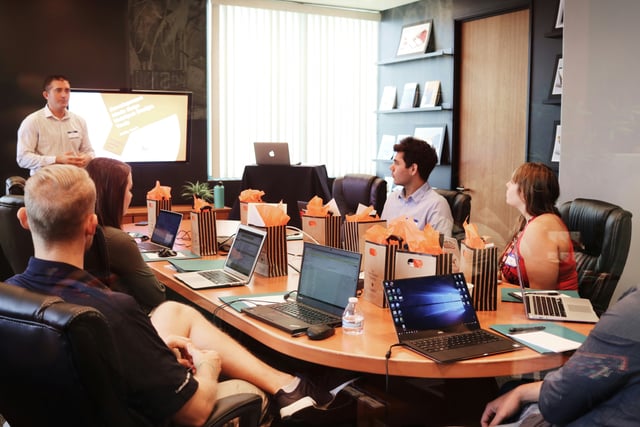How to Run Fair and Fast Performance Review Calibrations 2025
Learn how to run performance review calibrations that are both fair and efficient. Discover how AI and modern tech accelerate calibration meetings while reducing bias and ensuring consistency across teams.
Performance review calibration is often the bottleneck turning review season from weeks into months. Traditional calibration meetings are time-consuming, politically charged, and prone to the biases they’re supposed to eliminate. According to Lattice research, one company saved 2,000+ hours per cycle by modernizing their process.
In 2025, AI and modern technologies enable calibrations that are 3x faster while improving fairness and consistency. This guide explains what calibration is, why traditional approaches fall short, and how to run meetings that are both efficient and equitable.
What is calibration?
Calibration is the process of aligning performance ratings across managers and teams to ensure fairness, consistency, and objectivity. Instead of managers rating in isolation, calibration brings leaders together to normalize standards and eliminate disparities.
The purpose
Calibration solves a fundamental problem: different managers apply different standards. One manager’s “exceeds expectations” might be another’s “meets expectations.”
According to Culture Amp, calibration addresses:
Inconsistent standards: Managers interpret scales differently. Some are harsh graders, others lenient. Calibration creates shared understanding of what each rating level means.
Unconscious bias: Managers may unknowingly favor certain employees based on affinity bias, recency effect, or halo effect. Group calibration surfaces and corrects these biases.
Compensation fairness: Since ratings drive promotions and raises, calibration ensures equitable reward distribution based on contributions, not which manager you report to.
Why traditional calibration fails
Traditional calibration follows a labor-intensive, multi-step process:
- Managers independently rate direct reports
- HR collects ratings and prepares distribution summaries
- Managers prepare to defend ratings with documentation
- Leadership convenes for 3-6 hour calibration meetings
- Ratings are adjusted for consistency
- HR and senior leadership approve
- Managers communicate adjusted ratings to employees
Critical flaws
Time consumption: Organizations with 100+ employees spend entire weeks in calibration meetings, reducing availability for strategic activities.
Outdated data: By calibration time, performance data is often months old and no longer relevant.
Manager defensiveness: Calibration becomes a battleground where managers fight for their team’s ratings, turning fairness conversations into adversarial negotiations.
Paradoxical bias introduction: HBR research found calibration can actually introduce new biases. Persuasive communicators influence outcomes more than objective data.
Lack of transparency: Employees rarely understand what happens, leading to distrust when ratings change.
Over-reliance on curves: Traditional calibration focuses on forcing distributions into predetermined curves rather than accurate assessments.

How AI accelerates calibration
AI and modern platforms redesign calibration—making it faster, more data-driven, and fairer.
AI-powered discrepancy detection
AI instantly identifies:
- Similar performers receiving different ratings
- Managers consistently rating higher or lower than norms
- Rating patterns suggesting demographic bias
- Outliers requiring discussion
Rather than spending hours finding problems, committees spend time solving them.
Automated pre-read generation
AI generates comprehensive pre-reads including:
- Rating distribution visualizations
- Comparative performance data for similar roles
- Highlighted discrepancies
- Flagged bias patterns
- Individual summaries with supporting evidence
AI-powered platforms automatically generate these before meetings, allowing prepared arrival rather than real-time discovery. This dramatically reduces meeting length while improving quality.
Continuous data collection
Modern AI systems continuously gather year-round data from:
- Project management systems
- GitHub or GitLab
- CRM platforms
- Slack and email
- Calendar systems
By calibration time, comprehensive records exist—eliminating the “I don’t remember Q2” problem.
Real-time bias analysis
AI analyzes decisions in real-time, alerting committees when:
- Adjustments disproportionately affect demographic groups
- Justifications contain biased language
- Similar employees receive inconsistent treatment
Committees can course-correct during meetings rather than discovering problems after.
Conversational feedback collection
Conversational AI achieves 80-90% response rates vs. 50-60% for traditional surveys. Modern AI assistants chat with employees in Slack to gather calibration-relevant feedback year-round in under 30 seconds.
How to run modern calibrations
Step 1: Define standards before review season
Before reviews begin:
- Create rating rubrics with specific, observable behaviors
- Customize criteria by role
- Train managers on standards with practice scenarios
- Establish flexible distribution guidelines (avoid rigid curves)
Step 2: Implement continuous data collection
- Integrate performance platforms with business tools
- Gather feedback continuously after collaborations
- Track goal progress in real-time
- Document accomplishments when they happen
Step 3: Use AI to prepare materials
AI should:
- Generate rating distribution visualizations
- Identify outliers and discrepancies
- Create pre-reads with manager ratings, metrics, peer feedback, and comparisons
- Flag potential bias indicators
Windmill automates this, accelerating calibrations by 3x compared to manual preparation.
Step 4: Conduct focused meetings
With AI preparation, meetings become shorter and more effective:
- Prioritize discussing AI-flagged discrepancies, borderline ratings, and high-impact decisions
- Review AI summaries first for shared factual foundation
- Focus on evidence, not advocacy
- Document rationale for every adjustment
- Address bias patterns immediately
- Time-box meetings to 90-120 minutes (5-10 minutes per employee)
Step 5: Validate outcomes
Before communicating to employees:
- Run final bias checks across demographic groups
- Verify rating justifications are documented and objective
- Compare distributions to benchmarks
- Prepare manager talking points for rating changes
Step 6: Continuous improvement
- Survey participants on what worked
- Track time spent, rating changes, bias indicators, and satisfaction
- Adjust AI algorithms based on patterns
- Refine rating standards for next cycle
Best practices
Do
- Start early: Hold quarterly “mini-calibrations” to discuss trends and align on standards
- Include diverse perspectives: Committees with diverse membership make fairer decisions
- Make it transparent: Explain how calibration works to employees to build trust
- Calibrate goal setting: Ensure employees in similar roles receive similarly challenging goals
- Document everything: Create written records of decisions, rationales, and action items
- Train managers: Provide communication training, scripts, and FAQs for delivering outcomes
Don’t
- Force artificial distributions: Don’t penalize high-performing teams to meet predetermined quotas
- Allow loudest voice to win: Focus on data first, then manager input
- Skip manager training: Managers need confidence in communicating calibration outcomes
Common challenges and AI solutions
Manager defensiveness: AI-generated summaries focus discussions on data rather than manager judgment, reducing defensiveness.
Time consumption: Automated pre-reads reduce meeting time by 50-75%. Organizations report cutting time from weeks to days.
Recency bias: Continuous data collection provides complete performance records with examples from the entire period.
Identifying bias: AI instantly analyzes ratings across demographic dimensions, flagging disparities for review.
Inconsistent standards: AI compares similar roles across the organization, enabling calibration committees to align standards.
Lack of examples: AI pulls specific examples from integrated tools—projects, feedback, contributions—giving concrete evidence.

Real-world results
Organizations implementing AI-powered calibration report:
- 3x faster calibrations: What took weeks now completes in days
- Fewer rating changes: Better preparation means more accurate initial ratings
- Higher manager satisfaction: Less stress when calibration is structured and data-driven
- Better bias detection: AI catches patterns human reviewers miss
- Increased employee trust: Objective data drives ratings
- Earlier problem identification: Continuous monitoring surfaces issues months before formal reviews
Windmill accelerates calibration
Windmill delivers comprehensive automation:
- Automatic discrepancy detection: Flags inconsistencies instantly
- Pre-read generation: Comprehensive briefings before meetings
- Continuous context gathering: Windy gathers performance context year-round in Slack
- Bias pattern surfacing: Real-time alerts when adjustments disproportionately affect groups
- Complete integration: Connects with Slack, GitHub, Linear, Asana, Monday, Notion, Salesforce, Hubspot, Google Workspace, and more
Companies report 3x faster processes while improving fairness and reducing manager burden.
Key takeaways
- Traditional calibration is time-consuming and can introduce new biases
- AI instantly identifies discrepancies and generates comprehensive pre-reads
- Continuous data collection eliminates the “I don’t remember” problem
- Real-time bias analysis allows course correction during meetings
- Modern calibration completes in 90-120 minutes vs. all-day marathons
- Transparency with employees builds trust
- Document decisions and continuously improve the process
Performance review calibration doesn’t have to be a weeks-long ordeal. By combining clear standards, continuous data collection, and AI-powered analysis, organizations can run calibrations that are simultaneously faster and fairer.
Ready to experience 3x faster calibrations? Visit gowindmill.com to see how Windmill automates calibration preparation, flags discrepancies automatically, and helps organizations ensure fairness across their entire performance review process.